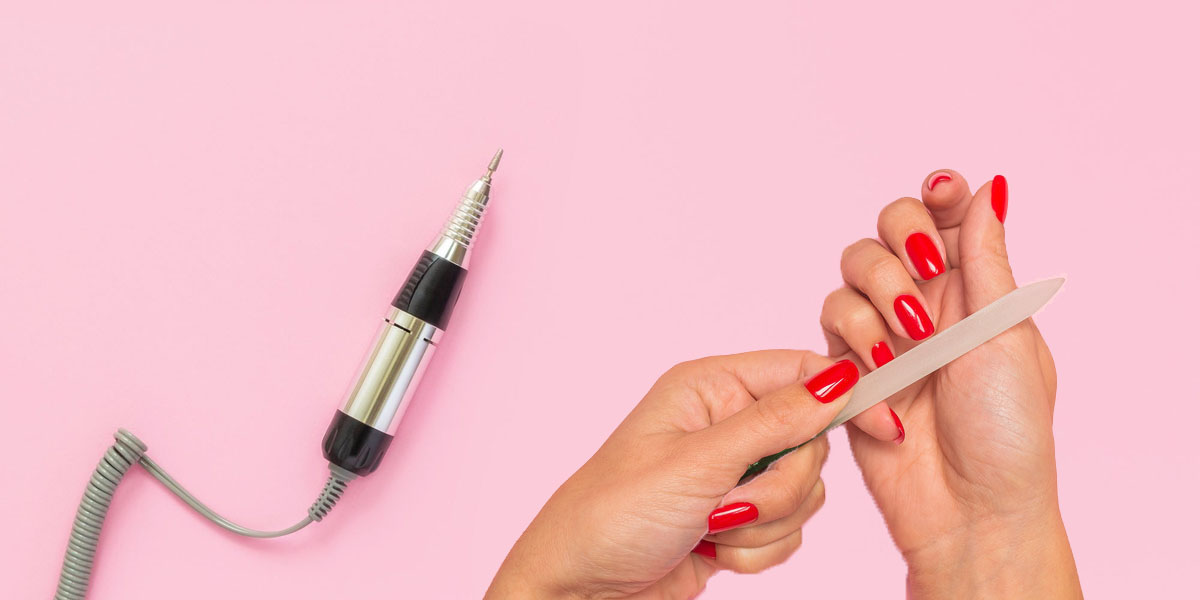Introduction
Nail care is more than just a beauty routine—it’s a matter of hygiene, style, and even self-expression. Whether you're shaping your natural nails or working on acrylics or gel overlays, the tool you choose plays a significant role. Nail files come in two primary types: manual and electric. Both have their strengths, weaknesses, and ideal use cases.
1. What Is a Manual Nail File?
Manual nail files are hand-operated tools made from various materials such as:
Emery boards (sandpaper-type): Ideal for natural nails; available in different grits.
Metal files: Durable and rough; better for artificial nails, but can be harsh on natural nails.
Glass/crystal files: Gentle, long-lasting, hygienic; perfect for precise shaping and sealing the nail edge.
Ceramic files: Non-abrasive and suited for sensitive or brittle nails.
These are typically used in home settings or for natural nail maintenance.
2. What Is an Electric Nail File?
Also known as an e-file or nail drill, the electric nail file is a powered device that rotates interchangeable heads at adjustable speeds.
Comes with different bits (carbide, diamond, ceramic, sanding bands).
Used for shaping acrylics, removing gel polish, smoothing calluses, and preparing the nail bed.
Found in two types:
Digital models (with digital speed controls)
Analog models (manual dial-based speed)
3. Comparison Table
| Feature | Manual Nail File | Electric Nail File |
|---|---|---|
| Ease of use | Easy for beginners | Requires practice |
| Speed | Slower | Much faster |
| Portability | Highly portable | Less portable |
| Maintenance | Minimal | Needs cleaning & sanitizing |
| Cost | Budget-friendly | Higher initial investment |
| Nail Type | Ideal for natural nails | Ideal for artificial nails |
| Precision | High | Very high with experience |
| Noise | Silent | Noisy (depends on model) |
4. When Should You Use a Manual Nail File?
Use a manual file if:
You’re maintaining natural nails.
You’re a beginner.
You want more control and less risk of damaging your nail bed.
You need a quiet, travel-friendly tool.
You’re not doing professional-level nail art or enhancements.
Best for:
Natural nail shaping
Quick touch-ups
Buffing the surface gently
5. When Is an Electric Nail File Better?
Use an electric file if:
You work in a salon or do professional nail work.
You regularly apply acrylics, gels, or dip powders.
You need to speed up your workflow.
You want precise and deep filing, especially near cuticles.
You require versatility with attachments.
Best for:
Nail prep and cuticle cleaning
Product removal (gel, acrylic)
Sculpting and refining nail shapes
Smoothing hard skin or calluses
6. Grit Guide: Understanding File Coarseness
Grit refers to the roughness of a file. The lower the number, the coarser the file.
| Grit Range | Use Case |
|---|---|
| 80–100 | Removing acrylic or hard gel |
| 180 | Shaping artificial nails |
| 240–320 | Shaping natural nails |
| 400–600 | Gentle buffing and finishing |
| 1000+ | Polishing and shining |
7. Safety & Hygiene Tips
Clean your tools: Electric bits and manual files should be disinfected after each use.
Avoid overheating: Electric files can cause friction burns if used too long on one spot.
Use the right speed: Higher speeds aren't always better; low-speed settings are safer for beginners.
Don’t share files: Especially manual files, unless properly sanitized.
8. Pros & Cons at a Glance
Manual Nail File
✅ Pros:
Cheap
Easy to use
Great for beginners
Gentle on natural nails
❌ Cons:
Slower
Requires more effort
Limited versatility
Electric Nail File
✅ Pros:
Fast and efficient
Versatile
Professional-level results
Saves time during long sessions
❌ Cons:
Expensive
Noisy
Needs experience to avoid damage
Requires sanitization
Conclusion
Choosing between a manual and electric nail file depends on your needs. For simple, everyday use, a manual file offers precision and control. If you're into professional-level nail art, extensions, or frequent gel removal, an electric file is a worthy investment. Whichever you choose, always follow hygiene and safety practices for healthy, beautiful nails.

